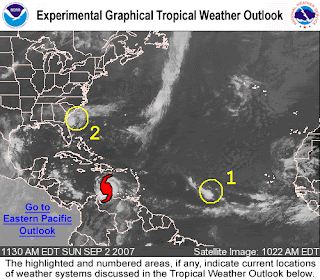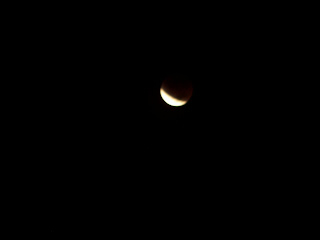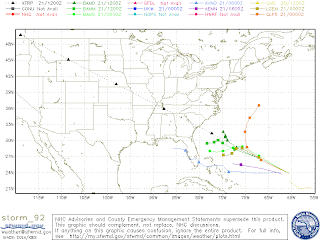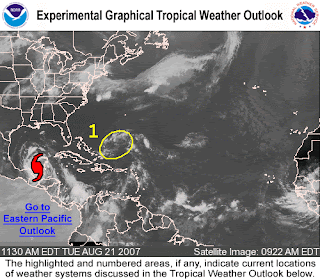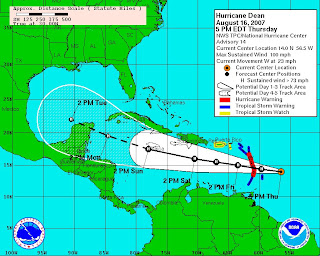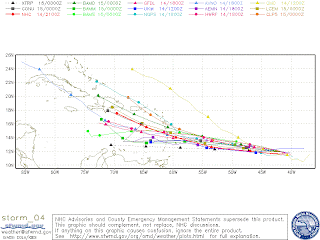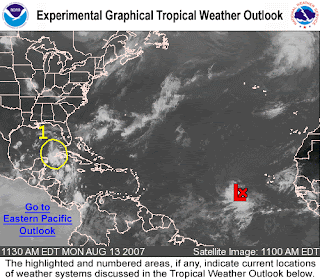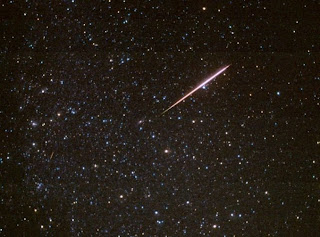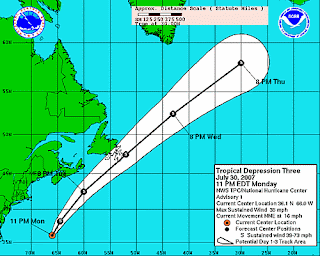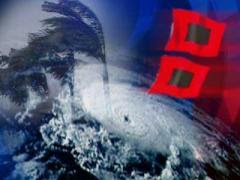


At times it feels like it's been longer, but other times it feels like yesterday. Today marks the second anniversary of Hurricane Katrina. On August 29, 2005 I was serving as Chief Meteorologist at WPMI-TV Mobile/Pensacola. We were in the midst of our wall to wall coverage of the storm that began 2 days earlier. Katrina would be the third major hurricane to arrive near our doorstep during one calendar year. Hurricane Ivan pounded our local coastline the September before and Hurricane Dennis rubbed salt in Ivan's wounds 2 months earlier. Of all the evacuation plans executed before, this one was the biggest.
My wife and children evacuated for the third time in less than a year. I sent them on their way the day before Katrina struck to seek refuge at my inlaws in Ft Payne, AL. As a meteorologist, I had some long hours ahead of me and I needed as much time as possible to prep our house and then be ready for the LONG work day(s) ahead. Having my family evacuated was a huge relief. I knew they were safe, and with my house secured with the storm shutters, I could then focus squarely on my job. Katrina was no surprise, we saw it coming and knew that once the storm passed over the Gulf Loop Current, its strength would grow. Mobile was not going to be the point of landfall, but it was going to be on the dangerous east side of the hurricane which would bring an incredible storm surge and high wind.
Sunday, August 28, our broadcast schedule required each meteorologist to work a 12 hour shift. So, I had a whole 1/2 day on the air, the other 12 hours spent prepping for the storm, forecasting, and trying to catch a nap. Most of that day was sunny and hot with intermittent periods of thunderstorms. To their credit, most Mobilians wasted no time getting ready for Katrina's visit. By sundown, all preparations came to a end and the worst of Katrina was nearing our doorstep. It was one of those days where I hoped my forecast would be wrong. The forecast included a 10-14 ft storm surge with wind exceeding 100mph.
Monday, August 29th is a day I will never forget. Katrina made the first landfall along the coastal region of Louisiana around 6am and then the second landfall along the Louisiana/Mississippi border. Mobile never noticed the difference. Since before 6am and through mid afternoon, the pounding wind and rain was being unleashed. All the while, the waters of Mobile Bay were being pushed into the city streets. The resulting storm surge brought a near record level of 13ft of water. Our broadcast plans were interrupted at about 9am when the station's generator caught on fire. This resulted in complete failure of the electrical system. During hurricane broadcasts, we would simulcast with area radio stations because so many people would lose power during the storm. With no power at the television building, we had to drive toward downtown to the radio building to continue our broadcasts. It was true "white knuckle" driving for a while with debris covered roads, and yet more airborne debris flying around. We spent the next 13 hours on the radio through midnight before a shift change. By midnight, the storm had passed and all that was left was DARKNESS. I attempted to drive home and what would normally be a 10 minute drive, took nearly an hour. Debris covered roads and no street lights made for a trip I will never forget. Once I got home, I was relieved that the house was intact except for the shingles sheared off the roof. I felt fortunate, because so many people were left homeless along the Alabama, Mississippi and Louisiana coast.
There are certain levels of exhaustion and emotion that I found myself going through before and after the storm. There is the physical exhaustion of boarding up and preparing your home while balancing the hours of my job which were quite demanding. Then, there is the mental exhaustion because of the anxiety building up before and during the storm. Emotional exhaustion would rise and fall before, during and after the storm. Telling your family goodbye and seeing your children leave with tears in their eyes because Dad has to stay behind...that's not easy. Seeing members of your community lose everything is tough to watch as you sit in a house that is still standing. And, it was not just the local community of Mobile. Areas to the west along the Mississippi and Louisiana coast saw total devastation. Many of those people migrated east toward Mobile for help. What still haunts me to this day are the dazed and lost expressions on their faces. They needed food, water and shelter. They had reached the point of desperation. Fortunately, the Mobile community provided their needs. There were long lines at grocery stores, and no gasoline anywhere for miles. Power was not restored for days, and trust me it was VERY hot those days after Katrina.
State and local officials in Alabama responded immediately and our region was spared the finger pointing and blame game issues that occurred to our west in Louisiana. I witnessed that aspect like many of you did via television reports. It was a totally different type of damage level with levee flooding than the quick in and out storm surge flooding we had on the Alabama coast. Their flooding would last much longer. the US Coast Guard headquarters for the Gulf region is in Mobile. They were flying rescue missions in MS and LA nonstop for days even during the storm. The sound of the helicopters filled the skies constantly.
During the 16 years of my career in meteorology, I hope I never see another year like 2004-2005. Ivan, Dennis and Katrina was enough experience for a lifetime. Despite the devastation I was thankful to be a part of a community getting back on its feet. I saw the worst in mother nature, but the best in mankind.
As I write this now during the heart of the 2007 hurricane season, I can say with 110% certainty, that I am glad to be back home in the Tennessee Valley :)
Pictures:
1: Landry's Restaurant - Biloxi, MS
2: West side of Mobile Bay, AL
3: Storm Shutters on our Mobile, AL home















